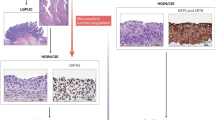Abstract.
Molecular and kinetic analyses have contributed to our understanding of the biology of transitional cell carcinomas (TCC) of the bladder. The concordant pattern of X-chromosome inactivation of multiple TCCs appearing at different times and at different sites and concordant genetic abnormalities in a subset of muscle-invasive TCC strongly support a monoclonal origin and a homogeneous tumor cell selection throughout the neoplasm. However, topographic intratumor heterogeneity results from the accumulation of genetic lesions in tumor suppressor genes, predominantly neurofibromatosis (NF)-1-defective in the superficial compartment and tumor protein p53 (TP53)-defective in the deep one, with lower proliferation and down-regulation of apoptosis in the latter. TCCs follow the general concept of multistep carcinogenesis and proceed through two distinct genetic pathways responsible for generating different TCC morphologies. These are the inactivation of cyclin-dependent kinase inhibitors (p15, p16, and p21 WAF/CIP1) in low-grade TCC and early TP53-mediated abnormalities in high-grade TCC. TCC progression correlates with genetic instability and accumulation of collaborative genetic lesions mainly involving TP53, retinoblastoma (RB)-1, and growth factors. Distinctive genetic (low incidence of RB-1 and NF-1 abnormalities) and kinetic (slower cell turnover) profiles also correlate with a "single-file" infiltration pattern and poor survival in muscle-invasive TCCs. The underlying molecular changes of carcinoma in situ involve multiple and more extensive deletions (normally TP53-defective) than coexistent invasive TCC, suggesting an independent genetic evolution, while low-grade dysplasia is mainly polyclonal and shows a low rate of gene deletions.
Similar content being viewed by others
Author information
Authors and Affiliations
Additional information
Electronic Publication
Rights and permissions
About this article
Cite this article
Baithun, S., Naase, M., Blanes, A. et al. Molecular and kinetic features of transitional cell carcinomas of the bladder: biological and clinical implications. Virchows Arch 438, 289–297 (2001). https://doi.org/10.1007/s004280000289
Received:
Accepted:
Issue Date:
DOI: https://doi.org/10.1007/s004280000289




